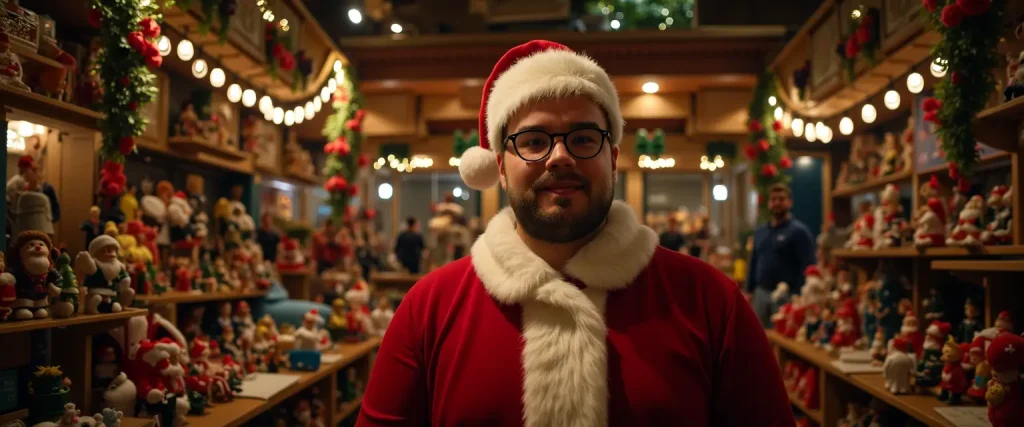In the spirit of the holiday season, I embarked on an exciting journey to explore the cutting-edge capabilities of FLUX.1, turning myself into both a professional LinkedIn influencer and Santa Claus through the magic of AI. This exploration not only showcases the remarkable progress in AI image generation but also demonstrates how accessible these technologies have become.
Understanding the Technical Sleigh: FLUX.1 and LoRA
FLUX.1, developed by Black Forest Labs, represents a significant advancement in text-to-image generation. I find it particularly fascinating how FLUX.1 has managed to overcome common challenges in image generation, particularly in areas like hand rendering and text legibility.
The model family includes three variants:
- FLUX.1 [Pro]: The premium commercial offering
- FLUX.1 [Dev]: A 12-billion parameter open-weight model
- FLUX.1 [Schnell]: An efficiency-focused variant for rapid development
What makes this holiday experiment particularly interesting is the integration of LoRA (Low-Rank Adaptation). Think of LoRA as the efficient packing algorithm for Santa’s sleigh – it dramatically reduces the computational overhead of model fine-tuning by introducing trainable rank decomposition matrices while freezing the base model weights. In practical terms, this means we can customize FLUX.1 with our own images using about 10,000 times fewer parameters than traditional fine-tuning approaches.
My North Pole Laboratory: Fine-tuning Process
Using Replicate’s infrastructure, I implemented a straightforward fine-tuning pipeline. The process was remarkably cost-effective and user-friendly:
- Data Preparation
- Selected 13 high-quality personal photos
- Ensured diverse angles and expressions
- I only used photos from my holidays
- Training Configuration
- Trigger word: ‚Patrick‘ (uniqueness is key for clear model recognition)
- Training steps: 1000 (optimal balance of quality and cost)
- Learning rate: Default (0.0001)
- Execution and Monitoring
- Training duration: ?? minutes
- Total computation cost: $??
- GPU utilization: H100 (Replicate’s standard for FLUX.1 fine-tunes)
Results: From Executive Suite to Santa’s Workshop
The results exceeded my expectations in both professional and festive contexts. For professional headshots, I used prompts like:
A professional headshot of Patrick in a modern office setting, wearing a suit,
high-quality DSLR photo, professional lighting, shallow depth of field, 85mm lens
For the Santa transformation:
A jolly portrait of Patrick as Santa Claus in his workshop, surrounded by
toys and Christmas lights, warm lighting, cinematic composition, festive atmosphere
The model demonstrated remarkable consistency in maintaining my facial features while adapting to different contexts. The professional headshots could easily pass for corporate photography, while the Santa portraits captured the warmth and joy of the holiday season.
Technical Insights and Best Practices
Through this experiment, I identified several key factors for successful fine-tuning:
- Dataset Quality
- Resolution matters more than quantity
- Consistent lighting improves model learning
- Varied expressions enhance generalization
- Prompt Engineering
- Specific technical details (lens type, lighting) improve output quality
- Consistent trigger word placement affects reliability
- Context-rich descriptions yield better results
- Performance Optimization
- 1000 steps proved optimal for this use case
- Higher resolution training images improved detail retention
- Batch size 1 provided the best stability
Economic Analysis: Holiday Budget Considerations
The entire experiment proved remarkably cost-effective:
- Training cost: $1.70 (20 minutes on H100)
- Generation cost: ~$0.03 per image
- Total investment: Under $2 for complete model customization
This pricing structure makes custom AI image generation accessible to individuals and small businesses, democratizing technology that was previously reserved for large corporations.
Future Implications and Seasonal Reflections
This holiday experiment demonstrates how far we’ve come in making advanced AI technologies accessible. The combination of FLUX.1’s sophisticated architecture and LoRA’s efficient fine-tuning approach opens up countless possibilities for personalized image generation.
Looking ahead, we can expect:
- Further improvements in fine-tuning efficiency
- Enhanced personalization capabilities
- More intuitive interfaces for non-technical users
- Broader applications in professional and creative contexts
Conclusion: The Gift of Accessible AI
As we wrap up this festive exploration, it’s clear that the barriers to entry for custom AI image generation are lower than ever. Whether you’re a professional seeking to create consistent personal branding or someone who wants to see themselves as Santa Claus, the technology is now within reach.
The combination of FLUX.1’s capabilities and LoRA’s efficiency, delivered through Replicate’s user-friendly platform, makes this holiday season particularly exciting for AI enthusiasts and creators alike. Now, if you’ll excuse me, I have some virtual presents to deliver!
Happy Holidays and Happy Training!
Schreibe einen Kommentar